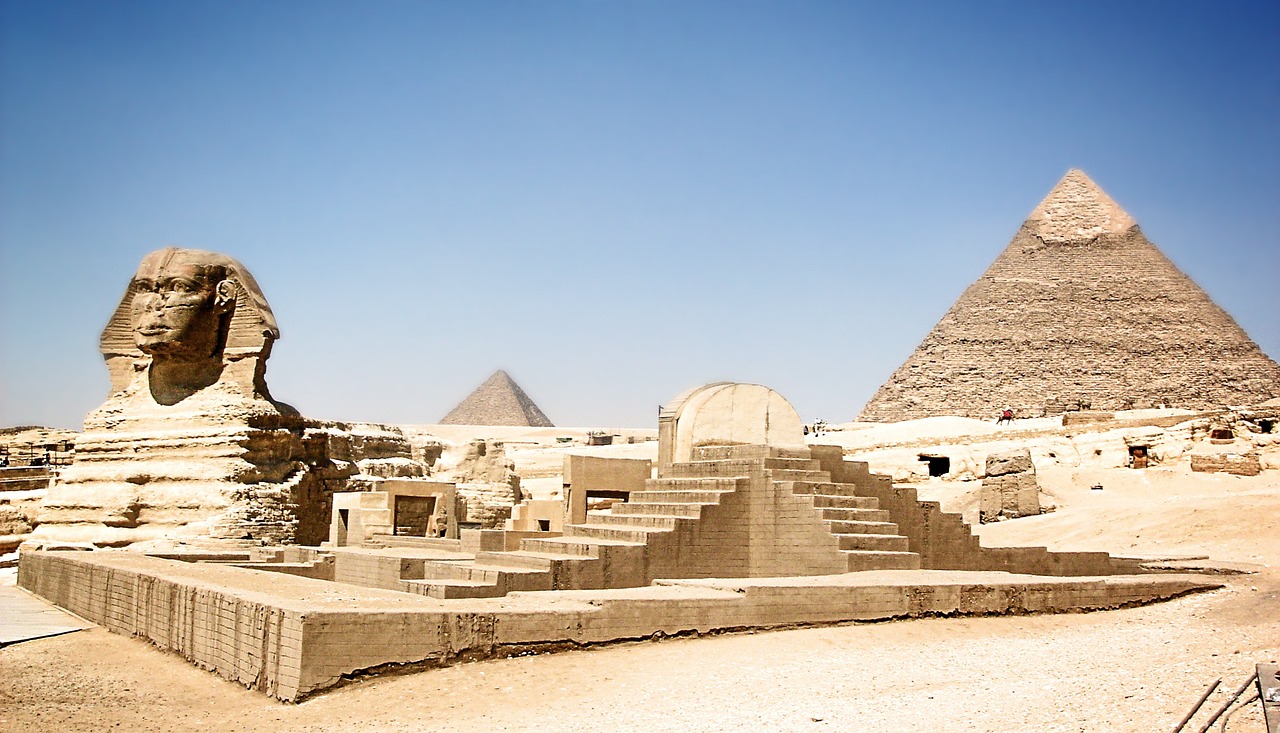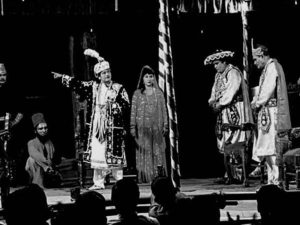Ancient Egypt’s mythology emphasized the cosmic order and the dualistic afterlife, with earthly and divine realms intersecting. Egyptian funeral rites and burial practices, including the Book of the Dead, mummification, and grandiose tombs, facilitated the soul’s journey through the afterlife. Osiris, the god of the afterlife, was central to the Egyptian pantheon’s cycle of death and rebirth. The deceased sought immortality through Osiris’s journey, and Pharaohs constructed pyramids as cosmic gateways, ensuring their ascension to heaven and eternal existence among the gods. Ancient Egyptians contemplated life, death, and immortality, leaving a lasting mark on time as they sought eternal echoes, transcending mortal and divine boundaries.
Ancient Egypt, a civilization rooted in mysticism and cosmic order, had a profound connection to the divine. The interplay between life and death was deeply ingrained in their beliefs, transcending mortal boundaries. The concept of eternal echoes was deeply ingrained in their psyche, guiding their intricate rituals, elaborate funeral practices, and pursuit of eternal existence. This exploration delves into the rich tapestry of ancient Egyptian cosmology, highlighting the intricate journey beyond life.

BELIEF IN THE AFTERLIFE:
Ancient Egyptians believed in the afterlife as a complex, ritualistic journey, guided by the cosmic order Ma’at. After death, the soul faced a perilous journey through the netherworld, where judgment awaited in the Hall of Ma’at. A lighter heart was considered worthy and granted passage to the afterlife. The afterlife was depicted in religious texts like the Book of the Dead, encompassing various realms and the underworld presided over by Osiris. Egyptians engaged in elaborate funeral rites and mummification processes to secure favorable outcomes. Pharaohs considered living gods, erected structures like pyramids as cosmic gateways, ensuring their ascent to the heavens and eternal union with the gods. This complex interplay between life and death in ancient Egypt reflected a deep connection to the divine, seeking to honor the departed and secure a transcendent soul continuity in the afterlife.
THE ROLE OF OSIRIS:
Osiris, a revered god in ancient Egyptian mythology, symbolized the cyclical nature of life and the promise of resurrection and eternal existence. He was the ruler of the Egyptian underworld, Duat, where souls embarked on their journey after death. Osiris’s tragic death resurrection, influenced by his brother Seth’s murder, symbolizes hope and assurance of an afterlife. His wife Isis reassembled his body, and through her magical abilities, Osiris had been resurrected, which represents hope and assurance. Osiris is associated with fertility and the Nile agricultural cycle. His death and resurrection were the results of the annual flooding of the Nile. His role as a just and benevolent ruler extended beyond the afterlife, serving as a moral and spiritual guide for the living. Pharaohs believed they were the living manifestation of Horus, son of Osiris and Isis. Osiris’ influence on Egyptian religious and funerary rites transformed the cultural and spiritual landscape.
RITUAL AND FUNERARY PRACTICES:
Ancient Egypt’s rituals and funerary practices were deeply rooted in their beliefs about the afterlife and soul journey. These practices aimed to ensure a smooth transition, protect the deceased from malicious forces, and secure a favorable judgment in the Hall of Ma’at. Mummification was a crucial aspect of burial customs, involving removing internal organs, treating them with natron, and wrapping them in linen. The Book of the Dead was a written literature that guided the deceased through the afterlife, providing spells, hymns, and directions on overcoming difficulties and communicating with deities. Personal belongings, food offerings, and burial equipment were buried with the deceased to ensure their survival. Wealthy people, particularly pharaohs, were buried with elaborate burial goods and valuables to ensure a fruitful afterlife. Amulets and charms were placed on the mummy or within the burial wrappings to protect the dead. Regular rituals were conducted during and after the funeral, with family members and priests conducting ceremonies and offering food, incense, and symbolic items to the tomb. Tombs were also chief components of Egyptian burial traditions, reflecting the deceased’s social position and the connection between the deceased and the God of the afterlife.
THE HALL OF MA’AT AND THE WEIGHING OF THE HEART:
The Hall of Ma’at, known as the Hall of Two Truths, was a significant concept in ancient Egyptian mythology and funerary beliefs. It was a place where the soul had scrutinized before its final destination was determined. Presided over by the Goddess Ma’at, it symbolized cosmic order, truth, and justice. The central event in this hall was the “Weighing of the Heart” ceremony, which was significant in the journey to the afterlife. The heart of the deceased represents an individual’s thoughts, emotions, and moral character, encapsulating their life and actions. A set of scales was placed, with the heart on one side and a feather representing Ma’at and the principles of truth and balance on the other. If the heart was as light as the feather, the soul was deemed justified, allowing them to proceed to the blissful afterlife, often associated with paradisiacal realms like the Fields of Aaru. The creature, Ammit, known as the “Devourer of Hearts,” was a composite being with the head of a crocodile, a lion’s forequarters, and a hippopotamus’s hindquarters. This grim fate meant the soul faced annihilation or eternal wandering without rest. The concept of the Hall of Ma’at and the Weighing of the Heart provided a moral framework for individuals in their earthly existence.
SYMBOLS OF IMMORTALITY:
Ancient Egypt, a civilization deeply rooted in religious beliefs and the afterlife, used symbols associated with immortality and life’s eternal nature in rituals, funerary rites, and art. The Djed pillar, a symbol of stability and endurance, was linked to Osiris and represented his spine. The Ankh, the “key of life,” symbolized life, death, and immortality with its loop. The scarab beetle, associated with the sun god Ra, represented transformation and regeneration. The Shen ring symbolized protection and eternity, with no beginning or end. The lotus flower, associated with creation and the sun god Atum, symbolized rebirth and life’s emergence from the waters. The Wadjet Eye, also known as the Eye of Horus, was a symbol of protection, healing, and resurrection, ensuring the
safety and well-being of the deceased in the afterlife. The Tyet knot, also known as the Knot of Isis, symbolizes life, fertility, and protection, often associated with the goddess Isis. The Benben Stone, a foundational stone, represents the primeval mound from which life emerged, linked to the creation myth and the birth of Ra, symbolizing the eternal and cyclical nature of Creation. Ancient Egyptian symbols of immortality were found in tombs and burial sites. It also played a significant role in religious ceremonies and daily life, highlighting the soul’s enduring nature and the quest for eternal life.
KA AND BA:
Ancient Egyptian beliefs emphasize the importance of the beliefs of “Ka” and “Ba” in understanding the soul’s nature and its journey in the afterlife. The “Ka” is an individual’s vital essence, present from birth and continuing to exist after death. Offerings of food and drinks were placed in tombs to nourish the ka in the afterlife. The “Ba”, or soul, is an individual’s spirit that can move and travel during the afterlife. After death, the Ba is believed to leave the body and journey through the afterlife, encountering challenges and visiting various realms. The Egyptian belief in the Ba and Ba is crucial in understanding their relationship with the afterlife. The ultimate goal is the reunion of the Ka and Ba, ensuring eternal existence. This understanding of the soul’s complexity influenced funerary practices, tomb decoration, and religious rituals in ancient Egypt.
CONCLUSION:
Ancient Egyptian tombs are a rich tapestry of symbolism reflecting deep beliefs about life, death, and the afterlife. Pyramids symbolize pharaohs’ ascension to the heavens and the eternal nature of the soul’s journey. False doors and stelae, etched with prayers and dedications, form bridges between the living and the dead, facilitating communication and offering for the departed. Burial chambers in the afterlife feature intricate scenes and inscriptions narrating the soul’s journey. Funerary art immortalizes individuals and guides them through the underworld. Amulets, scarab beetles, and ankh symbols serve as protective talismans. The Osiris bed represents the god of the afterlife and hope for resurrection. Canopic jars guard preserved organs, symbolizing bodily regeneration in divine realms. Ancient Egyptian tombs are sacred spiritual repositories that embody a civilization’s belief in the continuity of the soul, the cyclical nature of existence, and the enduring connection between the living and the departed. They were constructed with specific symbols and rituals to honor the deceased and secure a transcendent legacy, inviting us to unravel the mysteries of life, death, and immortality that echo through the sands of antiquity.



